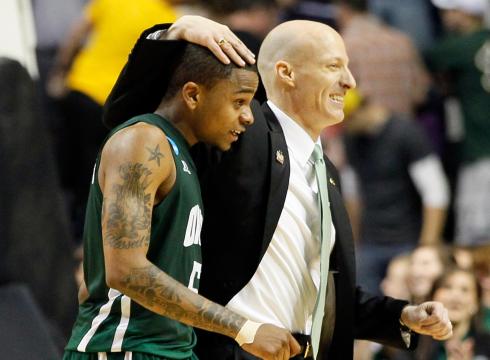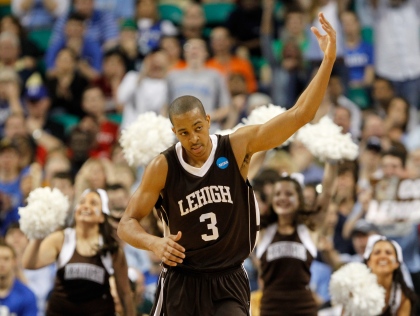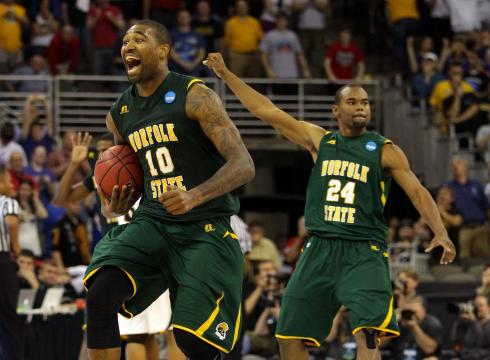The Other 26: And Then There Were Two
Posted by IRenko on March 23rd, 2012
I. Renko is an RTC columnist. He will kick off each weekend during the season with his analysis of the 26 other non-power conferences. Follow him on twitter @IRenkoHoops.
Thirty-three TO26 teams entered the greatest weekend in sports, and just two — Xavier and Ohio — survived to make it to the second weekend. This is the weakest showing for non-BCS teams since 2005, when only Wisconsin-Milwaukee and Utah made it to the Sweet Sixteen (where they were dispatched by Illinois and Kentucky, respectively). But that’s not to say that it wasn’t an exciting first weekend for the TO26. Indeed, Friday was a historic day, as not just one, but two #15 seeds notched wins. It was mad, it was March, and it was why we — especially those of us who relish the mid-major game as much as the high-major one — love college hoops.
Below, we take a look at how those 15 seed upsets confounded us and and how they didn’t, the likelihood that Xavier and Ohio will continue to carry the TO26 banner into deeper rounds, and reflect on the surprising and not so surprising first round losses suffered by some of the best TO26 teams.
The Survivors
Can the TO26 makes its mark on the regional final or — gasp — the Final Four?
Ohio — For the second time in three years, D.J. Cooper has taken the NCAA Tournament by storm, scoring 40 points in two wins. More generally, the Bobcats are a young, athletic, and dangerous team with a surprisingly high talent level for a MAC squad. Their #13 seed reflects a bit of trouble that they had in the middle of the season, but this team is playing better than that, almost as well as the ’06 George Mason and ’11 VCU teams did when they stormed the Final Four with a #11 seed.
Still, under normal circumstances, we wouldn’t give them great odds against a North Carolina squad that tends to dominate inside. But for those of you who just returned to civilization from a one-week absence, be advised that these are not normal circumstances. Kendall Marshall’s likely absence (or limited ability, at the least) may leave UNC vulnerable to Ohio’s turnover-generating defense and without the ability to run its vaunted transition offense. If the Bobcats can rattle the Tar Heels and UNC is unable to push the ball effectively, this could be a real contest. And after that, who knows? Kansas, with its effective interior game, would be a real challenge, but NC State would be eminently beatable. It is not inconceivable that the Bobcats could become the first team with a seed higher than 11 to land in the Final Four.
Xavier — The Musketeers’ two wins were microcosms of their seasons. Up and down and up again. They trailed Notre Dame by 10 points with 12 minutes left, but rallied to win by four. Against Lehigh, they trailed by 15 points late in the first half before going on a 29-7 run to take the lead. That the Musketeers won these games was no more surprising than the fact that they find themselves in the Sweet 16 after spinning into mediocrity for two months following their brawl with Cincinnati. And for those who remember their early season wins over Vanderbilt and Purdue early in the season, the trajectory of these Tournament games and the season itself are hardly unexpected. But can they pull it off again?
Unfortunately, Xavier is not well-positioned to take advantage of Baylor’s two key weaknesses: defensive rebounding and turnovers. Xavier doesn’t tend to force turnovers and they don’t crash the offensive glass all that well. But that’s not to say they can’t win. Defensively, the Musketeers’ tough pack-line defense will always give them a chance to stay in games. And offensively, steady guard play from Tu Holloway and Mark Lyons, punctuated by the ever-present possibility that they’ll go on a game-changing run, makes them a threat. Finally, Baylor always runs the risk of getting its own way, underachieving relative to its talent level. Of course, should Xavier get past Baylor, I don’t give them — much less anyone in the country — favorable odds in a likely matchup with Kentucky.
What Surprised Us
Memphis’ poor showing — The Tigers had been playing as well as anyone in the country heading into the Tournament. Their #8 seed was widely considered to be one of the biggest snubs suffered by any Tournament team. And they were playing a St. Louis team whose lack of athleticism seemed ripe for exploitation. But the Tigers came out tepid and uncertain. They lacked any offensive rhythm and seemed confounded by the Bilikens’ tight defense, particularly its emphasis on stopping transition buckets, even though this should have been no surprise. The offensive stagnation led to some poor shot selection, which in turn led to a shouting match between Will Barton and Chris Crawford on the bench. It was all downhill from there, leading Barton — who may be NBA-bound — in tears after the game, as he lamented his own selfishness, the fight with Crawford, and his failure to carry the team to a Tournament win. But Barton’s guilty conscience aside, I would put this loss on Josh Pastner, who did not seem to prepare his team for the kind of matchup they’d see.
Lehigh’s upset of Duke — In our preview piece, we noted that C.J. McCollum might have an easy time darting into the heart of Duke’s defense, given the Blue Devils’ mediocre perimeter defense this year. And sure enough, McCollum scored 30 points and notched 6 assists. And we also noted that the Mountain Hawks would have a tough time containing Duke’s three-point attack and Mason Plumlee. Sure enough, while Duke shot just 6-26 from three-point range, Plumlee was not easily contained, as he notched 19 points and 12 rebounds on a perfect 9-9 shooting night. But what we did not expect is that all this would add up to a Lehigh win. In the end, it was the small things that mattered here, all the little elements of the game that usually favor the highly-seeded BCS team. The Mountain Hawks held their own on the boards. They won the turnover battle. And they got to the free throw line much more than Duke did. (Of course, perhaps most significantly at all, Lehigh watched Ryan Kelly sit on the bench for 40 minutes, a factor that we did not account for.)
What Didn’t
The high seed “upsets” — Wichita State, Temple, UNLV, and San Diego State all suffered “upsets” in the first round, but frankly, none of these results was much of a surprise. Wichita State was the top-ranked TO26 team headed into the Tournament and of these four teams, was in the best form. But they had the misfortune of taking on everyone’s most hated matchup, Shaka Smart’s VCU and its “havoc” defense. With Garrett Stutz in foul trouble and the Rams swarming them, the Shockers were unable to run their half-court offense as they would have liked, resulting in a 38.7% FG shooting night that doomed them to defeat. As we observed last week, none of the other three teams to suffer an upset was in particularly fine form. UNLV continued its inability to win a meaningful game away from home. Incredibly, they attempted 23 more field goals than Colorado, but their horrid shooting (32.4%) doomed them to defeat. San Diego State’s tendency to force things on offense was on fine display against NC State. Jamaal Franklin is a good player, but has one of the odder approaches to shot selection that we’ve seen this year. Finally, Temple limped into the Tournament with just one regulation time win in its last five games. But they distinguished themselves against South Florida with an especially brutal offensive night. Here’s hoping that next year’s best TO26 teams are in better form heading into the Tournament and draw favorable early round matchups.
Norfolk State’s big win — As we noted last week, Norfolk State had a puncher’s chance at knocking off Missouri because of the matchup. It was no secret that Missouri was not as strong inside as it was on the perimeter. What was less known is that this played into Norfolk State’s strengths, as center Kyle O’Quinn is their featured piece on both offense and defense. But the Spartans wouldn’t have one without one big surprise — their three-point shooting. Despite a 31.5% 3-point shooting average during the season, the Spartans knocked down 10 of 19 attempts against Missouri. It was indeed “one shining moment” for Norfolk State’s three-point attack.












































